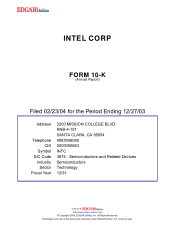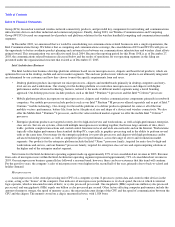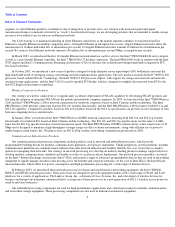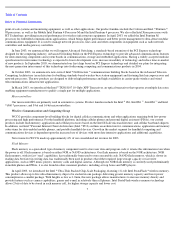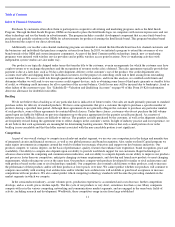Intel 2003 Annual Report Download - page 5
Download and view the complete annual report
Please find page 5 of the 2003 Intel annual report below. You can navigate through the pages in the report by either clicking on the pages listed below, or by using the keyword search tool below to find specific information within the annual report.
Table of Contents
Index to Financial Statements
Group (ICG) focused on wired and wireless network connectivity products, and provided key components for networking and communications
infrastructure devices and other industrial and commercial purposes. Finally, during 2003, our Wireless Communications and Computing
Group (WCCG) focused on component-
level products and platform solutions for the wireless handheld computing and communications market
segments.
In December 2003, we announced that we would be consolidating our communications-related businesses into a single organization, the
Intel Communications Group. We believe that as computing and communications converge, the consolidation of ICG and WCCG will give us
the opportunity to better coordinate product planning and customer focus between our communications infrastructure and wireless client efforts
going forward. This reorganization was not effective until fiscal 2004. Because the reporting period for this Form 10-K is as of December 27,
2003, the communications related businesses discussed below and the results of operations for our operating segments in this filing are
presented under the organizational structure that existed as of December 27, 2003.
Intel Architecture Business
The Intel Architecture business develops platform solutions based on our microprocessors, chipsets and board-level products, which are
optimized for use in the desktop, mobile and server market segments. The end-user products into which our products are ultimately integrated
are determined by our customers and how they choose to meet the specific requirements from end users.
Net revenue for the Intel Architecture operating segment made up approximately 87% of our consolidated net revenue in 2003. Revenue
from sales of microprocessors within the Intel Architecture operating segment represented approximately 73% of consolidated net revenue in
2003. Our microprocessor business generally has followed a seasonal trend; however, there can be no assurance that this trend will continue.
For the past five years, the company’s sales of microprocessors were higher in the second half of the year, primarily due to back-to-school and
holiday demand.
Microprocessors
A microprocessor is the central processing unit (CPU) of a computer system. It processes system data and controls other devices in the
system, acting as the “brains” of the computer. One indicator of microprocessor performance is its clock speed, the rate at which its internal
logic operates, which is measured in units of hertz, or cycles processed per second. One megahertz (MHz) equals one million cycles processed
per second, and one gigahertz (GHz) equals one billion cycles processed per second. Other factors affecting computer performance include the
amount of memory storage, the speed of memory access, the microarchitecture design of the CPU and the speed of communication between the
CPU and the chipset. The memory stored on a chip is measured in bytes, with 1,024 bytes
2
• Desktop platform products incorporate our microprocessors, chipsets and motherboards primarily in desktop computers and entry-
level servers and workstations. Our strategy for the desktop platform is to introduce microprocessors and chipsets with higher
performance and/or advanced technology features, tailored to the needs of different market segments using a tiered branding
approach. Our desktop processors include products such as the Intel
®
Pentium
®
4 processor and the Intel
®
Celeron
®
processor.
• Mobile platform products incorporate our microprocessors, chipsets and wireless communications components primarily in notebook
computers. Our mobile processors include products such as our Intel
®
Pentium
®
M processor offered separately and as part of Intel
®
Centrino
™
mobile technology. Our strategy for the mobile platform is to deliver products optimized for some or all of the four
mobility vectors: performance, battery life, form factor (the physical size and shape of a device) and wireless connectivity. We also
offer the Mobile Intel
®
Pentium
®
4 processor, and for the value notebook market segment we offer the mobile Intel
®
Celeron
®
processor.
• Enterprise platform products are targeted at entry-level to high-end servers and workstations, as well as high-performance enterprise-
class servers. Servers are systems, often with multiple microprocessors working together, that house large amounts of data, direct
traffic, perform complex transactions and control central functions in local and wide area networks and on the Internet. Workstations
typically offer higher performance than standard desktop PCs, especially in graphics processing and in the ability to perform several
tasks at the same time. Our strategy for the enterprise platform is to provide processors and chipsets with high performance and/or
advanced technology features, as well as competitive price for performance, across the range of server and workstation market
segments. Our products for the enterprise platform include the Intel
®
Xeon
™
processor family, targeted for entry-level to high-end
workstations and servers, and our Itanium
®
processor family, targeted for enterprise-class servers and supercomputing solutions at
the higher end of the enterprise market segment.

